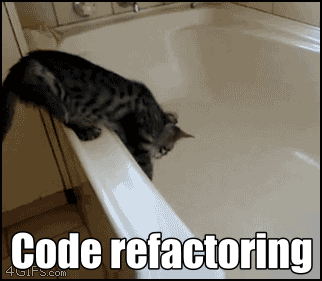After last night's Killers and Foo Fighters concert-slash-corporate-party—and the free Sierra and Lagunitas Salesforce provided, more to the point—today's agenda has been a bit lighter than the rest of the week.
Today's 10:30 panel was hands-down my favorite. Authors David Brin and Ramez Naam spoke and took questions for an hour about the future. Pretty cool stuff, and now I have a bunch more books on my to-be-read list.
At the moment, I'm sitting at an uncomfortably low table in the exhibit hall along with a few other people trying to get some laptop time in. So I will leave you with today's sunrise, viewed from the back:

I haven't traveled nearly as much this year as I did the past few, but only a week after my last trip, I'm away from home again. For a few days I'll be in San Francisco for Dreamforce '15, where the Force is with me dreams are forced upon you I'll learn about Salesforce and hobnob with other nerds.
Unfortunately, I left all of my laptop power supplies in Chicago. And, having had the same basic Dell model for the last five computers, I have quite a few. Fortunately, my office is sending me one.
So, today's entry will be mercifully short. Photos, and musings about cloud-based CRM, to follow when I have power.
During the first half of 2015, I took four trips, slightly fewer than the 22 I took in the second half of 2014. As of today I have four scheduled in the next three months—still not a huge number by historical standards.
This coming weekend I'm restarting the 30-Park Geas. Then from mid-August to mid-September I've got trips planned to downstate Illinois, London, and San Francisco, the last one to attend the Dreamforce conference.
It's still murder on my EQM numbers. It will hurt in 2016 if I can't somehow fly about 11,000 miles farther than I have planned through the end of 2015. Once you've gotten platinum status, you never want to go back.
At the new Inner Drive Technology World Headquarters, we have Xfinity Internet provided by Comcast. In the last couple of weeks, citing competition from just about everyone, Comcast upgraded Internet speeds in many of their markets, including Chicago:
Comcast announced Monday that it is raising the speed of its Blast Internet service to 75 Mbps, at no additional charge. The 50 percent increase will benefit about half of the company's high-speed Internet customers in Chicago, effective immediately.
For customers who need more than "extreme" speeds, Comcast is also launching the previously announced Gigabit Pro service, which delivers 2 Gbps upload and download speeds. That is 4 times faster than the top Internet speeds previously offered in Chicago by Comcast. The service requires installation of professional grade equipment outside and inside the home, and costs about $299 per month, a big jump in price as well as speed.
Well, I don't have gigabit speeds, but I do have this as of last night:

Yeah, OK. That'll work for now.
I'm reviewing a book I read about nine years ago, Why Software Sucks...and What You Can Do About It by David Platt. It feels like re-reading Keynes in 2008: really much more familiar than one would want, because no one seems to have learned much. From Chapter 1:
As with many areas of computing, user interface design is a highly specialized skill, of which most programmers know nothing. They become programmers because they're good at communicating with a microprocessor... But the user interface, by definition, exists to communicate with an entirely different piece of hardware and software: a live human being. It should not surprise anyone that the skill of talking with the logical, error-free, stupid chip is completely different from the skill of talking with the irrational, error-prone, intelligent human. ...
Because they're laboring under the misconception that their users are like them, programmers make two main mistakes when they design user interfaces. They value control more than ease of use, concentrating on making complex things possible instead of making simple things simple. And they expect users to learn and understand the internal workings of their programs, instead of the other way around.
The book is a little dated (October 2006), so some more, ah, concrete thinkers may have trouble getting past the 2006-era examples. But just like the idea that government investment can get an economy out of recession, the ideas in the book are still relevant and timely. Unfortunately.
Crain's Chicago Business has a web comic (of all things) that explains Motorola's decline from the only company making mobile handheld communicators to today's zombie corporation.
Spoiler alert: it was Iridium.
There's something kind of sad about spending several days extracting code I wrote for one company from code I wrote, while working at that company, for the company I now work for.
Then I gotta test it all...

Remy Porter at The Daily WTF points out the implementation issues with marriage equality:
In a landmark decision, the United States Supreme Court revised the business requirements and integrity constraints on the marriage relationship, removing some legacy constraints and essentially updating to better reflect the actual needs of their end users. This policy decision now has to be implemented in every state, county, town and hamlet across the country. Every change breaks somebody’s workflow, and this one is no exception.
In the end, this might not be changing requirements, as much as it might be poor assumptions. We’ve all seen articles like Falsehoods Programmers Believe About Time and Falsehoods Programmers Believe About Names. The choices we make in writing software can reveal our own assumptions and biases, and it behooves us in the industry to keep that in mind when interpreting business requirements. @qntm explores that idea from a database design perspective, both before the Supreme Court’s decision, and after.
Porter's post got me thinking about data design for marriage licenses, and the bad designs I've had to implement because of politics.
I've supported Kickstarter campaigns, including Exploding Kittens (shipping now!). Sometimes the campaigns explode; but sometimes, they fail miserably:
“There's a chasm between an idea, a design and a business which Kickstarter, Indiegogo and others really in some ways ignore,” says Michael Marasco, director of Northwestern University's Farley Center for Entrepreneurship and Innovation. “The reality is that there are tons of patents out there, tons of designs out there that have never become products.”
Kickstarter backers ostensibly understand this risk. The platform publicizes the fact that it is not a store but rather a way for people to work together to make things, so the specter of failure always lurks. Kickstarter participants do not own a stake in the companies they back. But that doesn't prevent them from becoming emotionally invested—and as delays mount, enthusiasm can morph into anger.
John Campbell, an artist in Wicker Park, raised $51,000 in 2012 for a comic book, “Sad Pictures for Children,” and shipped about 800 to backers. But in February 2014, after running out of money to send the rest, he grew so frustrated that he began lighting some of the remaining copies on fire—and posted video of the burning books to Kickstarter.
Less than 24 hours ago, I put my old camera on Craigslist: $500 for the body, two old lenses, the battery pack and charger, and a 32 GB CF card.
This afternoon, someone stopped by my office, played with the camera for five minutes, handed me $450 in cash, and that was it.
Thank you, Craig. That was remarkably painless.